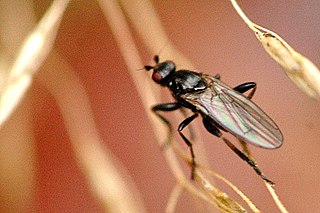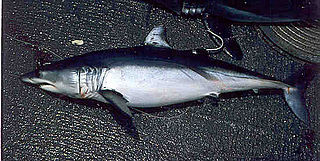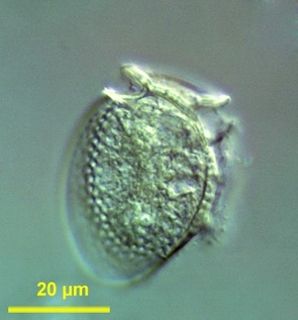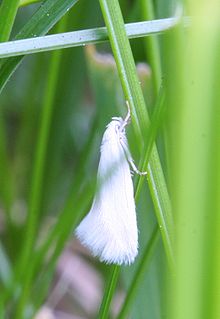
Armadillos are New World placental mammals in the order Cingulata. The Chlamyphoridae and Dasypodidae are the only surviving families in the order, which is part of the superorder Xenarthra, along with the anteaters and sloths. Nine extinct genera and 21 extant species of armadillo have been described, some of which are distinguished by the number of bands on their armor. All species are native to the Americas, where they inhabit a variety of different environments.
Genus is a taxonomic rank used in the biological classification of living and fossil organisms as well as viruses, in biology. In the hierarchy of biological classification, genus comes above species and below family. In binomial nomenclature, the genus name forms the first part of the binomial species name for each species within the genus.

A cockatoo is any of the 21 parrot species belonging to the family Cacatuidae, the only family in the superfamily Cacatuoidea. Along with the Psittacoidea and the Strigopoidea, they make up the order Psittaciformes. The family has a mainly Australasian distribution, ranging from the Philippines and the eastern Indonesian islands of Wallacea to New Guinea, the Solomon Islands and Australia.

The Vombatiformes are one of the three suborders of the large marsupial order Diprotodontia. Seven of the nine known families within this suborder are extinct; only the families Phascolarctidae, with the koala, and Vombatidae, with three extant species of wombat, survive.

A salp or salpa is a barrel-shaped, planktic tunicate. It moves by contracting, thereby pumping water through its gelatinous body, one of the most efficient examples of jet propulsion in the animal kingdom. The salp strains the pumped water through its internal feeding filters, feeding on phytoplankton.

The Polyporaceae are a family of poroid fungi belonging to the Basidiomycota. The flesh of their fruit bodies varies from soft to very tough. Most members of this family have their hymenium in vertical pores on the underside of the caps, but some of them have gills or gill-like structures. Many species are brackets, but others have a definite stipe – for example, Polyporus badius.
Phaedrolosaurus is a genus of theropod dinosaur, based on a single tooth possibly from the Valanginian-Albian-age Lower Cretaceous Lianmugin Formation of Wuerho, Xinjiang, China.

Sphaeroceridae are a family of true flies in the order Diptera, often called small dung flies, lesser dung flies or lesser corpse flies due to their saprophagous habits. They belong to the typical fly suborder Brachycera as can be seen by their short antennae, and more precisely they are members of the section Schizophora. There are over 1,300 species and about 125 genera accepted as valid today, but new taxa are still being described.

The Cerophytidae are a family of Coleoptera known as the rare click beetles. Adults are infrequently encountered, and larvae are found within wood, where they are believed to feed on fungi. The family contains over 20 species in five genera, primarily distributed in the New World: 17 fossil genera are known extending to the Early Jurassic.

The common dwarf mongoose is a mongoose species native to Angola, northern Namibia, KwaZulu-Natal in South Africa, Zambia and East Africa. It is part of the genus Helogale and as such related to Helogale hirtula.

Isurus is a genus of mackerel sharks in the family Lamnidae, commonly known as the mako sharks.
Bothriceps is an extinct genus of stereospondyl temnospondyl. It is a member of the infraorder Trematosauria and is the most basal brachyopomorph known. It is one of the only brachyopomorph that lies outside the superfamily Brachyopoidea, which includes the families Brachyopidae and Chigutisauridae. It shares several similarities to Keratobrachyops, another basal brachyopomorph, and may be closely related to or even synonymous with it.

Dinophysis is a genus of dinoflagellates common in tropical, temperate, coastal and oceanic waters. It was first described in 1839 by Christian Gottfried Ehrenberg.

Silvanidae, "silvan flat bark beetles", is a family of beetles in the superfamily Cucujoidea, consisting of 68 described genera and about 500 described species. The family is represented on all continents except Antarctica, and is most diverse at both the generic and species levels in the Old World tropics.

Elachista is a genus of gelechioid moths described by Georg Friedrich Treitschke in 1833. It is the type genus of the grass-miner moth family (Elachistidae). This family is sometimes circumscribed very loosely, including for example the Agonoxenidae and Ethmiidae which seem to be quite distinct among the Gelechioidea, as well as other lineages which are widely held to be closer to Oecophora than to Elachista and are thus placed in the concealer moth family Oecophoridae here.
Protococcidiorida is an order within the subclass Conoidasida of the phylum Apicomplexia. All members of this order are parasitic protozoa. The order was created by Kheisin in 1956.

Youngosuchus is an extinct genus of archosauriform from the Middle Triassic of China. The type species is Y. sinensis. Y. sinensis was first described in 1973 as a new species of the erythrosuchid Vjushkovia. In 1985, it was reassigned as its own genus of rauisuchid. A 1992 study supported the original classification of Youngosuchus sinensis as an erythrosuchid, but more recent studies classify it as a "rauisuchian"-grade loricatan archosaur completely unrelated to Vjushkovia, which is most likely a synonym of Garjainia.
Scalenodon is an extinct genus of traversodontid cynodonts from the Middle Triassic of Africa and possibly Russia. The type species S. angustifrons was named in 1946 and several other species were named in the following years. Most of the species from Africa are now thought to belong to different genera than Scalenodon.
The World Checklist of Selected Plant Families is an "international collaborative programme that provides the latest peer reviewed and published opinions on the accepted scientific names and synonyms of selected plant families." Maintained by the Royal Botanic Gardens, Kew, it is available online, allowing searches for the names of families, genera and species, as well as the ability to create checklists.
Blastogregarinorina is a suborder of parasitic alveolates of the phylum Apicomplexia












